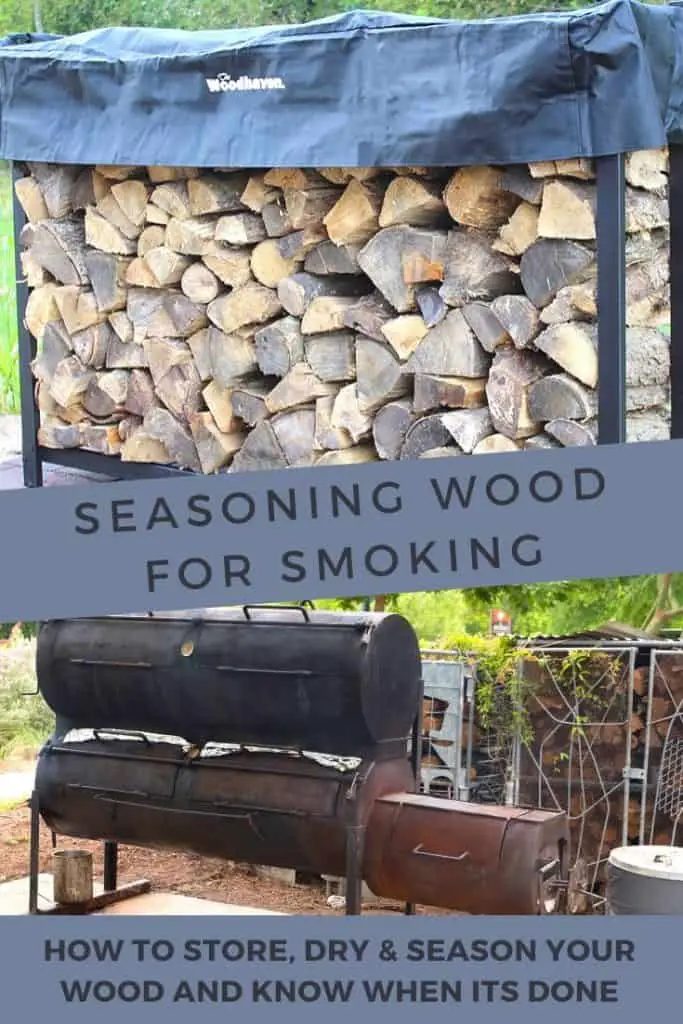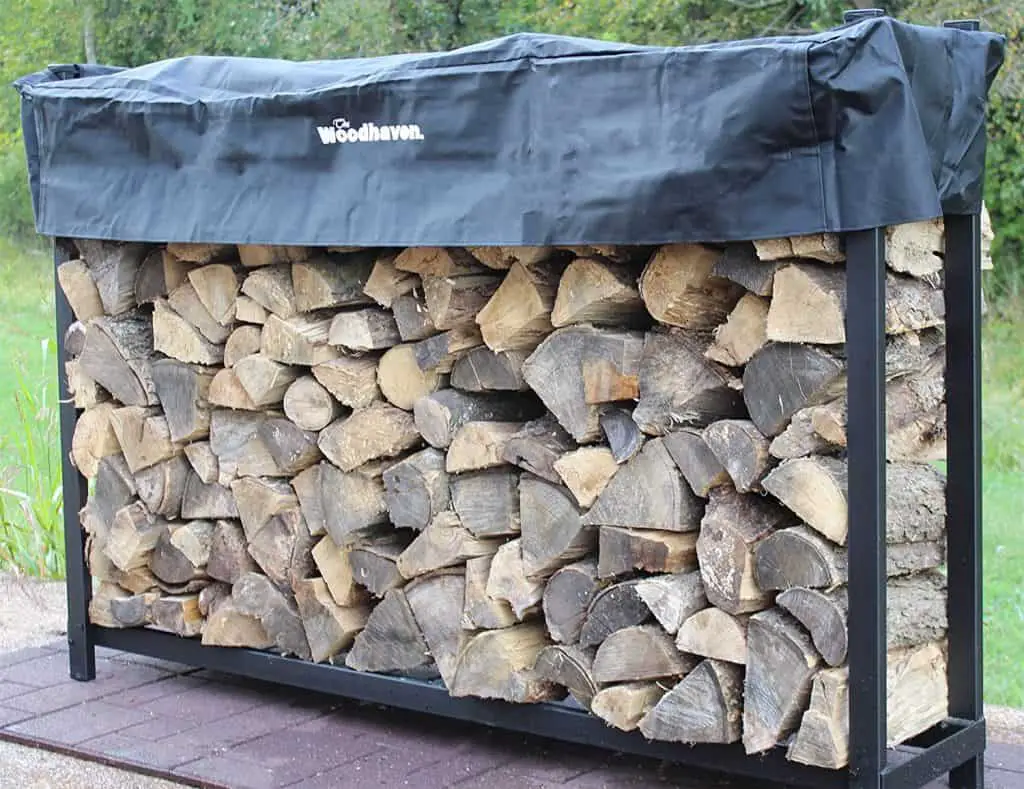Seasoning wood for a delicious, flavorful barbecue is not an overnight task. The process of seasoning begins many months ahead of time.
You might be wondering why seasoning wood for smoking is so important?
How long should you season wood before smoking?
Well-seasoned wood, wood that has been aged and dried, is the first step to a great tasting barbecue, and the whole seasoning process can take anywhere from 6 to 18 months. You shouldn’t go over 18 months because then the wood could lose its flavor.
Keep reading to find out all about methods to get the best flavors for your next smoking adventure.

This post is all about seasoning wood, but here are our pro tips on seasoning your grill as well
In this post we'll cover:
What does seasoned wood mean?
Seasoned wood means aged and dried wood and refers to the wood chunks or logs that are left outdoors to dry naturally.
Therefore, it contains just the right amount of moisture needed for smoking and cooking and is considered almost dry. This dried and aged wood is also known as cured wood.
Drying and Storage
There are two ways to dry wood:
- air-drying
- and kiln-drying.
Wood can be cured and seasoned naturally, meaning it is not treated with any chemicals and toxins, and it dries outside in the elements, known as air-drying.
Even when it rains, the wood will be fine because it will dry once the weather is nice and warm. So, regardless of season, the wood is still ‘seasoning,’ so you don’t need to protect it from the elements too much, a basic tarp cover is enough to protect the wood as it is drying outside.
Wood may also be kiln-dried, which means that the wood has been dried in a kiln (or pottery-type oven or furnace) at a much faster pace.
Storing wood (like we talk about here) properly is essential if you want high-quality wood for smoking. When storing and seasoning wood, make sure the wood is not stored directly on the ground. It should be slightly off the ground to make sure it doesn’t go moldy and damp.
Also, ensure that the wood is cut into relatively small pieces that will dry evenly. You don’t want half the wood to be wet and half dry! Consider investing in a firewood rack that will make it easy to store and season any type of wood.
I find this Woodhaven is very sturdy and holds the wood well for long periods of time:

As stated above, one with a simple cover is enough.
How do you prepare wood for the smoker?
The preparation process for smoking actually begins many months before use.
Measure your firebox or wood storage shed and cut your logs into a size that allows you to align them perfectly on top of each other. The wood has to be left outdoors for at least six months to make sure it dries and ages naturally in the elements.
To be safe, season your wood for one year. The overall consensus is that you shouldn’t season wood for more than 18 months because it can become too dry and lose its flavor.
Therefore, keep in mind that the ideal period for seasoning is between 6-18 months, and it doesn’t matter if it’s hot, cold, raining, or snowing, the wood will still season.
How do I know if the wood is seasoned?
There are some very easy to tell signs that your wood is properly seasoned:
- Your logs should have small dark cracks at the ends; that’s the first sign of seasoning.
- Another sign is the color of the wood; it should have a silvery tone to it if it’s properly seasoned.
- When you cut the wood with an ax, and it splinters easily, and the blade of the ax goes through with no difficulty, the wood is ready for smoking.
- Finally, consider the weight of the wood – the drier the log, the lighter it will be. Green logs are heavy because they are filled with moisture.
Well-seasoned logs should have as little moisture as possible, and to have an exact measurement of the moisture levels, you should buy a moisture meter.
You can pick up this Tavool moisture meter online from Amazon:

Why does the wood need to be dry?
Greenwood is not very suitable for smoking because it contains a lot of moisture. As green wood burns during the smoking process, the fire will only be drying out the wood and not generating that smoking flavor in the meat.
You’ll probably end up with an odd and undesirable taste. Dried wood, on the other hand, gives meat that specific smoking flavor.
The quality of the smoke is a determining factor for the outcome. Dry wood gives that quality smoke full of flavor smokers want.
What you need to know about smoke is that it is made up of about 100 different compounds.
The kind of smoke you’ll get depends on the type of wood you use, the burning temperature, the humidity level, and the oxygen levels during the smoking process.
Choosing a wood size for smoking
Before you begin smoking, you should measure the amount of wood you are going to use depending on the size of your smoker.
This can be done by placing the quantity of wood you think you’ll use into your grill and see how much you need to fill it up or complement the other fuel source if you are only using wood to smoke.
Now, it’s time to decide if you are using seasoned wood chips, wood chunks, or logs, depending on your smoking equipment.
Many smokers like to use wood chips because they are effortless to use. To get wood chips, either buy them at the store, use a woodchipper tool, or make chips by hand using a chisel or a bandsaw.
Chips tend to burn at a more consistent rate on a larger surface area. It’s recommended that you use wood chips for electric and gas grills.
I have the wood chips on my list of go-to BBQ smoker products.
Beware of the common myth that you should soak wood chips before smoking for non-gas grills. Some smokers like to soak the wood before smoking, but be aware that soaking may negatively affect the smoke that’s produced.
Instead of the thin, blue-colored smoke you need, you may end up with a billowing puff of white smoke that won’t benefit your meat.
Experts who researched the soaking method concluded that soaking isn’t necessarily worth the effort because it does not improve taste and flavor.
There are some exceptions in which you should soak wood chips, especially if you are going to use external smoke boxes on top of the cooking grates.
- Wood chunks: Chunks are smaller pieces of wood, about the size of a fist or slightly bigger. Igniting them may take more effort than chips, but once they are on fire, they will burn for approximately one hour on a grill and for up to several hours in a smoker. The advantage of chunks is that they are cheap and can even be found while scavenging through a forest or park.
- Logs: Logs are the larger pieces of wood you typically used in a fireplace or for an outdoor campfire. These are easily used with offset smokers or in fire pits. When using seasoned logs, it will take time for them to reach the right temperature for smoking as well as get a perfect amount of smoke from them. Since logs are large pieces of wood, they work best with larger cooking equipment.
If using logs and chunks, you’re probably wondering if you need to strip the wood of its bark, just know that there is no specific rule to follow: you can choose to leave the bark on the wood or shave it off.
However, there is a special recommendation for fruitwood.
Usually, you don’t need to take off the bark of fruit woods like cherry, apple, or peach. Fellow smokers advise leaving the bark on because it adds to the flavor.
Some types of wood, such as birch, have a bark that contains oil, which can give off a sooty smoke that you don’t want to cover your meat, so remove the bark. In general, most types of wood are better used without bark in the smoker.
Since the bark protects the tree from external elements, it can contain pollutants and will make the meat taste acrid.
How to use seasoned wood
Now, onto the actual smoking part, you’ll have to add the right amount of wood to your smoker.
BBQ with Franklin talks about using seasoned wood in his video:
If the wood is the primary fire source, you’ll need a larger quantity. If you are using another fuel type for the smoker, you want to add less wood because the only purpose of the wood will be to smoke.
Old-school smokers prefer to use wood as their main fuel source, and they cook the meat on a wood-fueled grill. The best smoke is produced by a steady fire that’s burning at a hot temperature.
If you decide to use gas, charcoal, or electricity as your primary fuel source, be prepared to vary the smoking time and wood quantity. As you master the art of smoking, you may begin to mix different types of wood to achieve unique flavor combinations.
After all, smoking is all about personal preference and comfort, so choose what works best for your equipment.
What you should remember, though, is that seasoning doesn’t require a lot of effort, but it takes a long time.
As long as you leave the wood outside to dry naturally without molding, you’ll be fine and ready to smoke up some flavor!

